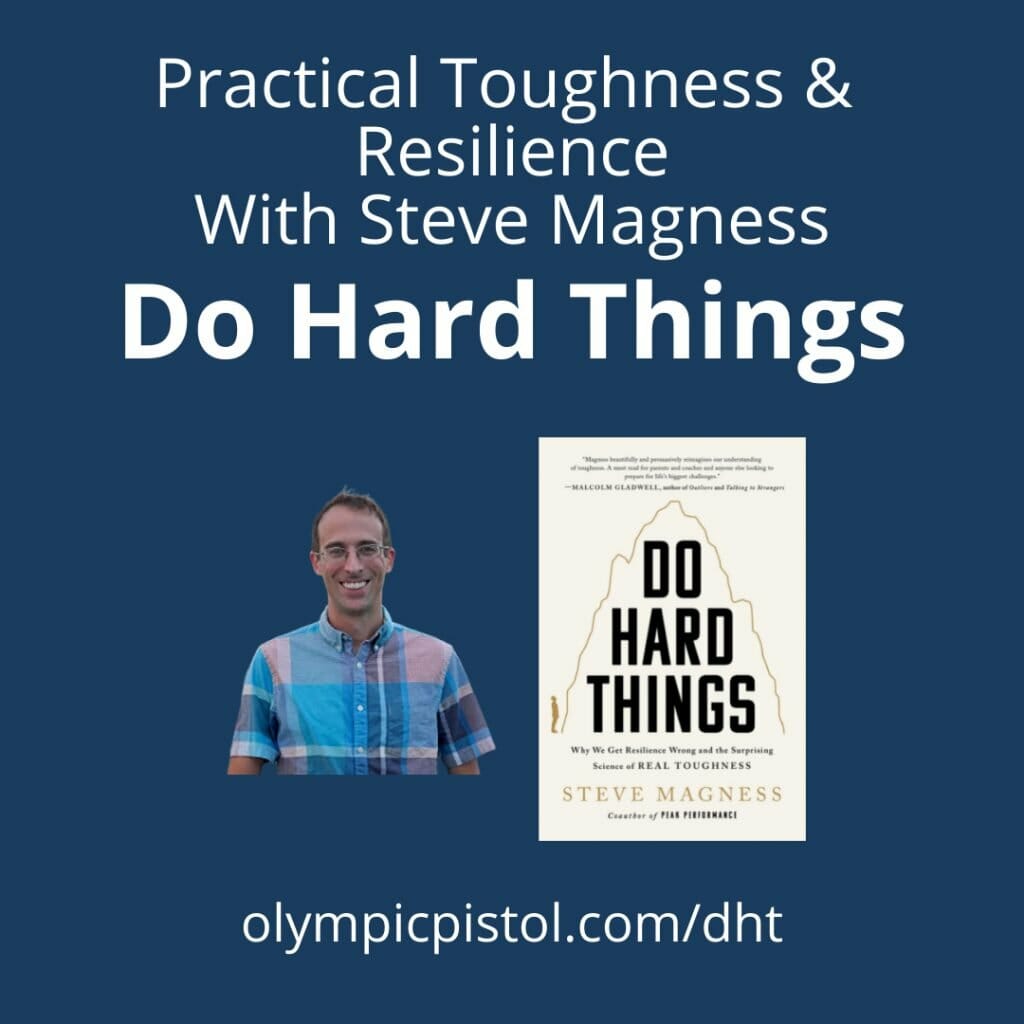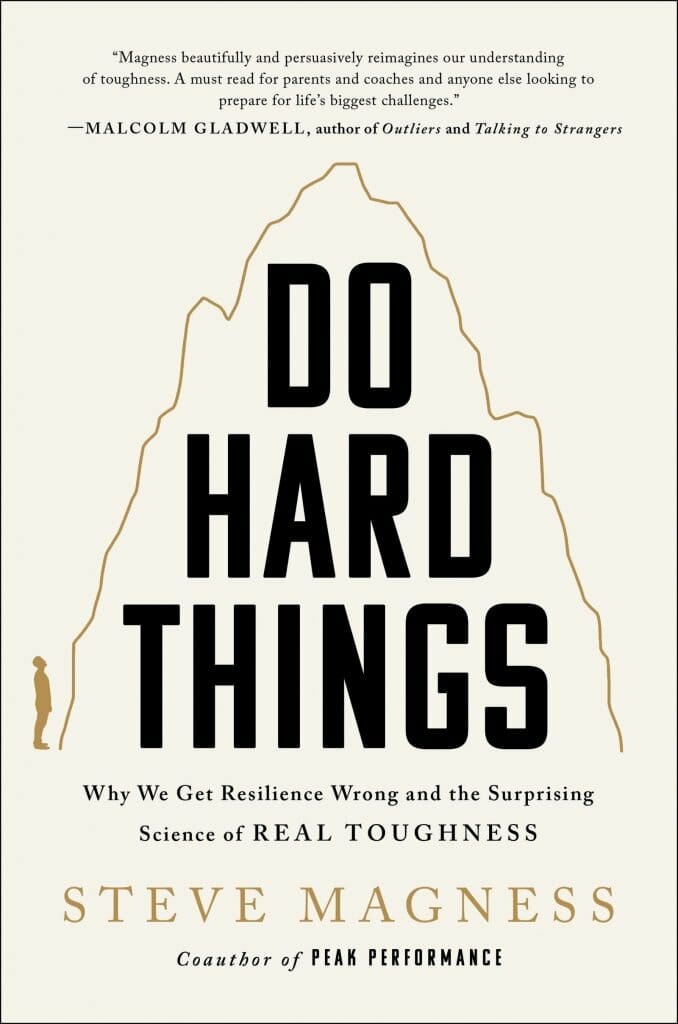Do you fit the topical image of what toughness should look like? You and I are not alone in not fitting it. Luckily for us Steve Magness comes to the rescue with science in his new book Do Hard Things: Why We Get Resilience Wrong and the Surprising Science of Real Toughness (all links to Amazon in this article are affiliate links). I have bought the book as soon as it was available to pre-order and responded to one of Steve’s emails proposing an interview for all of us sport shooters that have to face the difficulties of our sport in competition and training, to take on our difficult challenges without falling into the fake toughness trap. I’m really looking forward to reading it from today (release day!).
Steve is also the author of author of Peak Performance, The Passion Paradox, The Science of Running (I’ve read the first two and rated them both 5*), and The Growth Equation blog and newsletter; he’s also a speaker, podcaster, and a prolific social media communicator (Twitter, Facebook, Instagram). You always learn good stuff from him.

Table of Contents
Who are you and why does it matter?
I am a performance coach with a background in psychology. What that means is that I try to help people do better at whatever they’re performing. My experience is in athletics and track and field, but since my own competitive days I’ve branched out to trying to apply the same lessons in whatever endeavor people pursue. I look at the physical and mental performance of athletes, executives, and business people. I focus on the performance principles that apply across domains.
What is Do Hard Things about? What are the main lessons from it?
My new book is all about what I call resilience or mental toughness, which I’m sure you are familiar with in the world of shooting. I try to redefine it in a way that I think will apply to your readers. You understand that traditionally, especially in the US, we see toughness as this thing where we just kind of put our head down and grit through and just push through. And that’s not how our brain works.If we want to be able to perform at our best whenever we’re under high pressure and high uncertainty, we kind of have to not force our way through, but essentially accept and be able to navigate through. For instance in your sport you feel the pressure anxiety, you get a little bit of nerves. But how do you keep your mind and body steady so that you can execute? How do you stay on your process? That’s what I’m looking at, some of the ways that we can navigate all that stress, uncertainty, anxiety and still perform at our best. In shooting you have it much more difficult than other sports because every single step along the way your mind risks going on a spiral.

Which are the four pillars of resilience and toughness you talk about in your book?
The number one is to ditch the façade and embrace reality. What I mean by that is that often when we think of challenges, we think “Okay, I’ve got to go in and be completely optimistic, and have all this confidence in the world, and never think about quitting or anything like that”. But what research and psychology show is that it’s not about faking your way through it: it’s embracing the reality of the situation. We do much better when we know what the task is, what the demands are, and when we can evaluate if we meet those demands.
The second pillar is listening to your body, which deals with navigating that voice in your head, the doubts, the “oh my gosh, I’m messing up in the middle of the shot”. How do we deal with that? A second part of it is the accompanying feelings and emotions that come with that voice. It is not about ignoring those things but rather about acknowledging that we are going to have negative thoughts and how we are going to deal with them.
The third pillar is respond instead of react. Reaction is when we get in that survival mode where we’re just trying to escape and get through. Responding is when you create the space to be able to navigate whatever it is you’re going through. I’ve never competed in shooting, but I would think that it is being able to reset and get your mind back to what you’re doing during the current shot instead of thinking about the last one that went wrong, or what have you. That’s responding, because you’re coming back to the place and saying “OK, I’ve got to do this”.
And then the fourth pillar is transcending discomfort, which is like zooming out almost from the individual and looking at how our environment can allow us to get through and handle challenging times. It encompases things like having meaning and purpose in what you do, having the support environment that encourages productive risk taking (the feeling that even if you fail at this activity or pursuit, it’s not the end of the world). It is about setting your environment up so that it isn’t not a do or die situation.
I wrote this book because I wanted to explore where the science in psychology was because there are certain things that you can do to help. The way I like to think of it is that your brain is a protector, it’s all about protecting you. Unfortunately one of the ways that it thinks about protecting you when you mess up is to go “Oh, I’m gonna have value in that and grasp on to that”, and when you’re in the middle of competing you don’t want to be evaluating, you want to be focused on the task at hand. So you have to figure out how to drag it back to reality, what situation am I really facing right here?
When I read the title Do Hard Things I immediately thought about investing effort and delayed gratification. Is this part of the book?
Yes, delayed gratification is a big part of it, because what we humans want is the here and now. What our brain wants is a solution right now to the difficult moment we are facing, trying to get away from that feeling of anxiety or discomfort. Delayed gratification is about being able to sit with that experience and navigate it. Often what you see is that when you do challenging things it is very difficult at the moment, but there is a payoff in the long term. Do we take the easy route, which is often the short term solution? Or do we go towards the difficult path and push our mind and body? Delayed gratification is about what’s best over the long haul.
How can you prime the eagerness to do the hard things so that someday you may have a result?
Basically there are a couple of different things. One of them is the pillar I mentioned about embracing reality. This is important. How are you setting yourself up over the long haul? How are you approaching the activity that you’re doing?
I’ll use an example from my sport, track and field running. If I sign up for a marathon, and I realize “Hey, this is going to take a lot of work, and it is going to be difficult” that’s the appropriate expectation. If I sign up for a marathon and I say “Oh, this is a piece of cake, I’ve run all my life, no problem” then the first time it gets difficult or challenging it will be like if an alarm went off in our brain that says “Whoa! Whoa! What the heck, this was supposed to be easy”. And now that it is difficult all your brain wants to do is to hit the eject button, to get out, to escape. On the flip side, if I went into that marathon and said “Hey, this is going to be the most difficult thing in the world. I don’t know how I’m going to survive this”, my brain kind of goes into survival mode and doesn’t let me perform up to my capabilities because it says “Hey, this is supposed to be the craziest thing you’ve ever done, I’m going to be super cautious”. A lot of being able to prime yourself to do the hard thing is to have appropriate expectations so that you don’t have either that under or overreaction whenever it really gets difficult and you start doubting, or start wanting to quit.
In your previous books you highlight the importance of long term and intermediate goals for performance. How do you set up and manage them?
It all comes back to your motivation behind doing the task and how do we keep that fire burning. Because the long term goal is great, but if it’s too far off and you don’t think you’re making progress your motivation will suffer. That’s why we have these kinds of intermediate checkpoints. This is easy to say and difficult to implement.
Setting up these checkpoints are things at varying levels of difficulty that allow me to make sure that I’m on the path towards making progress.
I’ll give you an example using our marathon analogy. The temptation is to make all the objectives about performance (I will run this distance at this time, and that will tell me that I’m good to go). That can be great. But what happens if you fail that performance metric? Some performance metrics can be fine, but I also want things in there like “I want to be able to get in a long run once every week four or five weeks in a row” or whatever it is that you want that is tangible. Yes, there’s a performance side to it, but it’s about completion and not necessarily about the time or place behind it, which means that it’s a little bit easier to accomplish and gives me something to move forward.
The important thing here is how do I make sure that I’m still moving forward, even if occasionally I take side steps or move backwards? You need something to grasp onto over the long haul that reminds you that you are still making progress, that you are still working towards your goal, even if it’s not perfect.
The flip side of having these pursuits that we want to master is how to keep the motivation and joy behind it. This is the really important part, if you look at the research literature it essentially says that you’ve got to have just enough internal motivation. That beats out the external motivation (external motivators are rewards, the prizes, the feeling of winning all that good stuff…). We need just enough just a little bit more intrinsic, or internal motivation that keeps that fire going over the long haul and as we go through difficult things. And how do we cultivate that intrinsic motivation? The research says it’s finding joy in the activity itself; joy and feeling alive when you’re doing an activity. We also cultivate it by being able to make progress, and feeling that the activity is something bigger than just you and yourself, meaning tha maybe it’s part of your community or it’s part of your friend group, or what have you.
How about balancing work, rest and stress?
It is tricky. Balancing stress and rest and all that is good, but when you’re pursuing anything at a high level for a certain period of time you’re going to be unbalanced because you are prioritizing something and saying “Hey, this is really important”. The key is being able to have the self awareness to answer: is this a choice that I want to make?; do I want to pursue this sport at this level, at this time in my life, knowing that these other things over here on the side are going to be kind of neglected to be great? If you make that choice, great. That’s fantastic. But you have to be able to make that choice. You don’t want the thing, whether that’s running or shooting or whatever, almost being like this addictive thing that is making the choices for you. Right?
And then the other part that I think is really important for maintaining the motivation is feeling like we can make an impact, having autonomy over whatever it is we’re doing. It should not be forced upon us, nor feel like a job or a chore all the time. Sometimes it will, but not all the time. We’re actively choosing to pursue the thing and then choosing to see how good we can get.
Mastery is a main motivator for a lot of people in sports. Can you measure mastery? Do you think it can ever be achieved?
Good question. I don’t think necessarily you can objectively measure mastery, but I think you can have an understanding of where you are on that path. I’m not so sure you can achieve it either, but I think it’s this path that you can always go down. I like to think of it almost like craftsmen: they’re always tinkering and working on things, and it’s just for that pursuit and for that enjoyment of it. Especially as we age this is how we should look at sport: it’s about understanding the sport, and then figuring out how to get better or not even get better… Sometimes it is an appreciation for the sport for what it is.
I’ll give you an example in my own sport of track and field and running. As I get older it’s inevitable: I’m never gonna run as fast as I did when I was young, aging always wins. But what I can do is get a deeper understanding for how to pursue that sport, for how it’s supposed to feel, for what it brings to me, for how to navigate some of the discomfort that running at any pace or effort brings, and getting a deeper appreciation for it. Often mastery is about having this deeper appreciation for both the sport and also about how you pursue it. If we can have those kind of aha moments as we age, I think those will keep us motivated and allow us to perform at our best.
